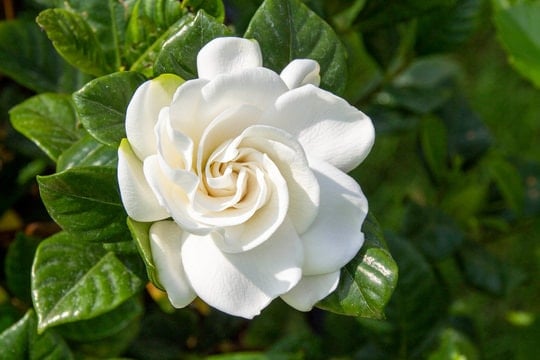
Chinch Bugs vs. Sod Webworms: Spotting the Difference in Your Florida Lawn
Whether you’re a new homeowner in Florida or a long-time resident, you already know that conditions in the Sunshine State…

If you’re a Florida gardener, you know that gardenias are a must-have in any landscape. With their lush green foliage and intoxicatingly fragrant white flowers, gardenias are a true Southern favorite. But have you ever wondered why your gardenias aren’t living up to their full potential? The answer might lie in your fertilization routine. In this article, we’ll share the secrets to properly nourishing your gardenias, so you can avoid the #1 mistake Florida gardeners make with these beautiful plants.
If you have any questions about gardenia care or need help selecting the right fertilizers and gardening products, feel free to reach out to our expert team at Council Oxford. We’re always happy to assist fellow gardening enthusiasts!
Before we dive into the nitty-gritty of fertilization, let’s take a moment to understand the gardenia plant itself. Gardenias are evergreen shrubs that can grow up to 8 feet tall and wide, depending on the variety. They prefer warm temperatures and humid conditions, making them perfect for Florida’s climate. Some of the best varieties to grow here in Florida include “Miami Supreme”, “Belmont”, “August Beauty”, and “Mystery”.
Gardenias seem to do best in well-drained soil that has good organic matter in it, and has a pH between 5.0 and 6.5. For organic matter, look to add some Comand compost! When it comes to sunlight, gardenias prefer full sun, partial shade, or shifting shade.
To keep your gardenias thriving, they need a balanced diet of essential nutrients. The three primary nutrients are nitrogen (N), phosphorus (P), and potassium (K), often represented by the NPK ratio on fertilizer labels. Gardenias also benefit from secondary nutrients like magnesium and micronutrients such as iron, manganese, and zinc.
If your gardenias are lacking in nutrients, they’ll let you know. Here are some common signs of nutrient deficiencies:
– Yellowing leaves: Nitrogen or iron deficiency
– Stunted growth: Nitrogen or phosphorus deficiency
– Purple-tinged leaves: Phosphorus deficiency
– Brown leaf edges: Potassium deficiency
When selecting a fertilizer for your gardenias, look for a balanced, slow-release formula with an NPK ratio of 12-6-8 or 10-4-10. Alternatively, you can use an acid-loving plant fertilizer specifically designed for gardenias, azaleas, and camellias. When you choose a fertilizer, try to use a product with at least 30% slow-release nitrogen.

Here in Southern Florida, you should fertilize your gardenias at least three times per year. Aim for February, October, and in the summer months. Avoid fertilizing during the winter months, as this can lead to tender new growth that is vulnerable to cold damage.
For optimal results, fertilize your gardenias every 6-8 weeks during the growing season. This consistent nutrient supply will keep your plants healthy and promote abundant flowering.
By timing your gardenia fertilization just right, you’ll be rewarded with a stunning display of fragrant blooms that will be the envy of your neighborhood.
Before applying fertilizer, make sure your soil is in tip-top shape. Gardenias prefer slightly acidic soil with a pH between 5.0 and 6.5. If your soil is too alkaline, you can lower the pH by incorporating elemental sulfur or peat moss.
When applying fertilizer, follow these simple steps:
1. Measure out the appropriate amount of fertilizer based on the size of your gardenia and the fertilizer label instructions.
2. Sprinkle the fertilizer evenly around the base of the plant, starting about 6 inches away from the trunk and extending to the drip line (edge of the foliage).
3. Gently work the fertilizer into the top inch of soil using a hand cultivator or rake.
Aim to water your gardenias roughly one inch per week. Deeper, longer watering is better than shorter, shallower watering (watering every day for 5 minutes). After fertilizing, give your gardenias a deep watering to help distribute the nutrients and prevent fertilizer burn. Apply a 2-3 inch layer of organic mulch, such as pine straw or bark chips, to conserve moisture, regulate soil temperature, and suppress weeds.
In addition to proper fertilization, gardenias thrive in Florida when provided with:
– Partial shade: Protect your gardenias from harsh afternoon sun.
– Consistent moisture: Water deeply and regularly, especially during dry spells.
– Good drainage: Plant gardenias in raised beds or amend heavy soils with organic matter to improve drainage.
We would also recommend mixing some Comand compost, just a little bit, into the existing media to give it the organic matter it wants.
Despite your best efforts, gardenias can sometimes fall prey to pests or diseases. The most common pests are scales, mealybugs, and whiteflies. Gardenias also see a fair amount of sooty mold, which comes from these insects. Here are a few common issues and their remedies:
– White flies, scales, and mealybugs: We always like to recommend using a systemic insecticide such as ImidaPro 2SC to protect against insect damage
– Sooty mold: Control the insects producing honeydew (the food source for the fungus) and gently clean the leaves.
– Yellow leaves with green veins: Apply chelated iron to correct this nutrient deficiency.
You should prune your gardenias in mid-summer right after the plant finishes blooming. Remove any dead, damaged, or crossing branches, and trim back leggy growth to encourage a more compact form.
With a little know-how and some TLC, you can unlock the secret to growing show-stopping gardenias that will be the talk of the town. By nourishing your gardenias with the right fertilizers at the right time, you’ll be rewarded with an abundance of fragrant blooms and lush, healthy foliage.
To encourage more blooms on your gardenias, be sure to test your soil and make sure your pH is correct. Too low of a pH will discourage growth and blooming. Also follow the guidelines for light and fertilization, because when you do all these things properly, then you have the best chance at success.
So go ahead, put your newfound knowledge into practice, and get ready to enjoy the stunning results! And remember, if you ever have questions or need advice on gardenia care, the friendly experts at Council Oxford are just a phone call or email away.
